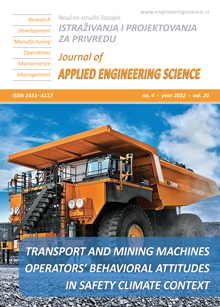EVALUATION OF ULTRASONIC PULSE VELOCITY (UPV) FOR REINFORCED CONCRETE CORROSION
Abstract
This study was undertaken to evaluate the efficiency of the ultrasonic test for detecting reinforcement corrosion levels under varying conditions and to form a correlation between the ultrasonic pulse velocity (UPV) values and the flexural capacity of corroded beams. To establish this, several reinforced concrete beams were cast and subjected to an impressed current accelerated corrosion process. The severity of corrosion was then investigated using the UPV test and four-point loading test. The results showed that the UPV test values vary with the corrosion level of reinforcement in concrete beams. However, the degree of variation in UPV test values at different levels of corrosion does not permit a clear cut for the evaluation of corrosion severity, particularly at low levels of corrosion. The four-point testing of corroded beams showed that corrosion affects the flexural capacity and ductility of the beams. This effect was correlated in this study with the UPV test values. The correlation analysis showed that there exists a moderate to a high positive correlation between the UPV test values and flexural capacity of the beams while a low negative correlation between the UPV test values and ductility of the beams was observed.
References
Al-Akhras, N. and Aleghnimat, R. 2020. Evaluating corrosion deterioration in self-compacted reinforced concrete beams and prisms using different tests. Construction and building materials. 256, (2020), 119347.
Committee, A.C.I. 2019. Building code requirements for structural concrete (ACI 318-19) and commentary. (2019).
Ervin, B.L. et al. 2009. Monitoring corrosion of rebar embedded in mortar using high-frequency guided ultrasonic waves. Journal of engineering mechanics. 135, 1 (2009), 9–19.
Hussain, R.R. 2011. Underwater half-cell corrosion potential bench mark measurements of corroding steel in concrete influenced by a variety of material science and environmental engineering variables. Measurement. 44, 1 (2011), 274–280.
Li, D. et al. 2014. Corrosion monitoring and evaluation of reinforced concrete structures utilizing the ultrasonic guided wave technique. International Journal of Distributed Sensor Networks. 10, 2 (2014), 827130.
Liu, D. et al. 2022. Evaluation of Corrosion Damage in Sulfate-Attacked Concrete by CT, Ultrasonic Pulse Velocity Testing and AHP Methods. Sensors. 22, 8 (2022), 3037.
Ndagi, A. et al. 2019. Non-destructive assessment of concrete deterioration by ultrasonic pulse velocity: A review. IOP Conference Series: Earth and Environmental Science (2019), 12015.
Nematzadeh, M. et al. 2021. Prediction of ultrasonic pulse velocity in steel fiber-reinforced concrete containing nylon granule and natural zeolite after exposure to elevated temperatures. Construction and Building Materials. 273, (2021), 121958.
Reis, H. et al. 2005. Estimation of corrosion damage in steel reinforced mortar using guided waves. (2005).
Saleh, E. et al. 2022. Guide to non-destructive concrete strength assessment: Homogeneity tests and sampling plans. Journal of Building Engineering. (2022), 104047.
Saleh, E.F. et al. 2022. A comprehensive evaluation of existing and new model-identification approaches for non-destructive concrete strength assessment. Construction and Building Materials. 334, (2022), 127447.
Sharma, S. and Mukherjee, A. 2011. Monitoring corrosion in oxide and chloride environments using ultrasonic guided waves. Journal of Materials in Civil Engineering. 23, 2 (2011), 207–211.
Xu, Y. and Jin, R. 2018. Measurement of reinforcement corrosion in concrete adopting ultrasonic tests and artificial neural network. Construction and Building Materials. 177, (2018), 125–133.
Yeih, W. and Huang, R. 1998. Detection of the corrosion damage in reinforced concrete members by ultrasonic testing. Cement and concrete research. 28, 7 (1998), 1071–1083.
Yodsudjai, W. and Pattarakittam, T. 2017. Factors influencing half-cell potential measurement and its relationship with corrosion level. Measurement. 104, (2017), 159–168.
Zhang, R. et al. 2010. Concrete cover cracking with reinforcement corrosion of RC beam during chloride-induced corrosion process. Cement and Concrete Research. 40, 3 (2010), 415–425.
Zhou, Y. et al. 2015. Carbonation-induced and chloride-induced corrosion in reinforced concrete structures. Journal of Materials in Civil Engineering. 27, 9 (2015), 4014245.

